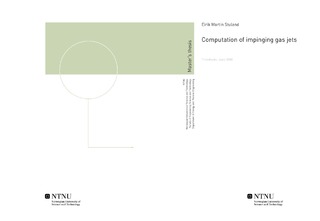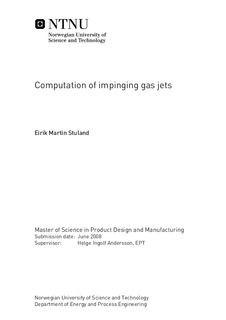| dc.description.abstract | Abstract This dissertation has been produced during the spring semester of 2008 to serve to the requirements for the degree of Master of Technology at the Norwegian University of Science and Technology (NTNU). The thesis has been written at the department of Energy and Process Engineering, with supervision of Professor Helge I. Andersson from the Fluid Dynamics department. The thesis has the title Computation of Impinging Gas Jets , and aims to investigate the Impinging Jet Flow (IJF) problem presented in section[2] by means of Computational Fluid Dynamics (CFD). For the work of this thesis the commercially available program package of FLUENT 6.3, and Gambit 2.4 was used for all the simulation and geometry generation tasks. The specific IJF case treated in the thesis work, is the Single Round Nozzle (SRN ) IJF geometry explained in section[2.2] , and displayed in Figure 2.2 . The numerical simulations were carried out by means of 2D and 3D Reynolds Averaged Navier Stokes ( RANS) simulations , and Large Eddy Simulation (LES) with related theory described in the theory section[3]. The work with the simulations of this thesis can roughly be divided into two main components. Firstly there is the part comprising all tasks and operations involved in creating and running the simulations, about which relevant information is provided in section[4]. Secondly, there is the work involving all the tasks related to gathering, interpreting, and analyzing the yielded simulation results. These tasks and their results are mainly treated in sections[5 to 9]. Both numerical and experimental reference IJF cases were used in this thesis work. The reference cases were at first used to guide the beginning of the simulation effort (Figure 6.1). In the later stages of the thesis, the reference results were used to analyze and interpret the results of the thesis simulations. Overall the results from the RANS simulations of this thesis, are found to give good agreement with the reference simulations and experiments, within the limits of what can be expected from the RNG k-ε model which was used. The LES simulations on the other hand, proves to be far more demanding both computation wise, and in relation to issues concerning simulation preparations and setup. In addition the LES simulation is found to be outperformed by the RANS simulations in some regions of the IJF geometry. When analyzed, it is found that this is probably caused by an unfortunate combination of regions with low local mesh quality, and a quite mesh sensitive feature in the Sub Grid Scale model. Nevertheless the LES simulation is found to provide results of good agreement with experimental data in some of the most difficult regions to simulate on the IJF geometry. In this region the LES simulation is also found to outperform the RANS simulations. | nb_NO |

